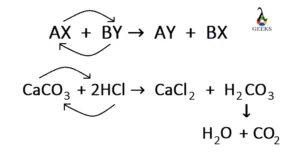Calcium carbonate (CaCO3) is basic, and it easily reacts with the strong acid, HCl. Let us explain the different relevant facts of the reaction in detail.
The reaction between HCl and CaCO3 is an example of an acid-base reaction or neutralization reaction. No more heat or external pressure is required for this reaction. This is an exothermic reaction which indicates that the products are more stable, and they possess less energy than the reactants.
Let us talk about the reaction type, products, intermolecular forces, enthalpy, balancing method, and conjugate pairs of this reaction.
What is the product of HCl and CaCO3?
The metal carbonate, CaCO3 reacts with the strong acid, HCl, and produces calcium chloride (CaCl2), carbon dioxide (CO2), and water (H2O). Carbon dioxide is always released through the solution when a metal carbonate reacts with the acid.
CaCO3 (aq) + 2HCl (aq) = CaCl2 (aq) + CO2 (g) + H2O (l)
What type of reaction is HCl + CaCO3?
The reaction between HCl + CaCO3 is an example of an acid-base reaction or neutralization reaction. In this reaction, acid, HCl is completely neutralized by the basic substance, CaCO3 to form salt and water.
How to balance HCl + CaCO3?
The following steps should be followed to balance a chemical reaction-
- Write the unbalanced chemical equation first with right arrow sign. CaCO3 (aq) + HCl (aq) → CaCl2 (aq) + CO2 (g) + H2O (l)
- Count the number of moles present for each element in the reactant and product side.
| Elements | No of moles in reactant side | No of moles in product side |
| Ca | 1 | 1 |
| C | 1 | 1 |
| O | 3 | 3 |
| H | 1 | 2 |
| Cl | 1 | 2 |
- To balance both sides (reactant and product) we have to multiply 2 with HCl to balance the number of moles of hydrogen and chlorine.
- Therefore, the balanced equation will be – CaCO3 (aq) + 2HCl (aq) = CaCl2 (aq) + CO2 (g) + H2O (l).
HCL + CaCO3 Titration
Back titration is required in this reaction HCl + CaCO3 because calcium carbonate is not soluble in water.
Apparatus
250 ml beaker, 250 ml volumetric flask, conical flask, burette, pipette (25 ml).
Indicator
Phenolphthalein is known as an acid-base indicator.
Procedure
- Solid CaCO3 is taken in a beaker and HCl is added to it. After mixing it properly, the whole mixture is transferred to a 250 ml volumetric flask and made up to the mark with distilled water.
- Pipette out 25 ml of the solution from the volumetric flask and put it in a conical flask. Phenolphthalein is added to the conical flask as an acid-base indicator.
- Titrate the solution with 0.1 M sodium hydroxide (NaOH) taken in a burette until pale pink color appears.
- Repeat the titration at least three times for accuracy and take the average of the titer values.
- Using the formula “V1S1 = V2S2”, the purity within CaCO3 is determined accurately.
HCl + CaCO3 Net Ionic Equation
The net ionic equation of the chemical reaction HCl + CaCO3 is-
CaCO3 (s) + 2H+ (aq) + 2Cl– (aq) = Ca2+ (aq) + 2Cl– (aq) + CO2 (g) + H2O (l).
HCL + CaCO3 Conjugate Pairs
The conjugate pairs (pair of compounds differ by one proton) equation of HCl + CaCO3 is-
HCl + CaCO3 = Cl– + HCaCO3+.
HCl and CaCO3 Intermolecular Forces
The intermolecular forces act on HCl and CaCO3 are-
- The electrostatic force of attraction is on CaCO3 because it is an ionic compound. The Ca2+ and CO32- ions are attached through this strong attraction force.
- Being a covalent compound, dipole-dipole interaction and London dispersion forces are working on HCl molecules.
HCl + CaCO3 Reaction Enthalpy
The enthalpy change of the reaction HCl + CaCO3 is -15.2 KJ/mol and it is obtained from the mathematical calculation written below.
- The enthalpy of the reactant side is -1206.9 KJ/mol (for CaCO3) and 167.16 KJ/mol (for HCl). The enthalpy values for the product side are -877.1 (CaCl2), -285.83 (H2O), and -393.51 (CO2) KJ/mol.
- The change of enthalpy = {Enthalpy (products) – Enthalpy (reactants)} = [-877.1 – 285.83 – 393.51 – {-1206.9 + 2×(-167.16)}] KJ/mol. = -15.22 KJ/mol.
Is HCl + CaCO3 a buffer solution?
HCl + CaCO3 is not a buffer solution because it is not a mixture of either a weak acid and its conjugate base or a weak base and its conjugate acid. In this mixture, HCl is a strong acid and CaCO3 is a metal carbonate that acts as a base.
Is HCl + CaCO3 a complete reaction?
HCl + CaCO3 cannot be a complete reaction because it is only the reactants written here. If the products are also written with reactants then it will be considered as a complete reaction.
Is HCl + CaCO3 an exothermic or endothermic reaction?
HCl + CaCO3 is an example of an exothermic reaction because the change of enthalpy is negative in this reaction which is -15.22 KJ/mol.
Is HCl + CaCO3 a redox reaction?
HCl +CaCO3 is not a redox reaction because in this reaction no electron transfer is taking place. It is a neutralization reaction occurring between an acid and a base.
Is HCl + CaCO3 a precipitation reaction?
HCl +CaCO3 is not a precipitation reaction because the products are not obtained as a precipitate. Calcium chloride (CaCl2) is completely soluble in water and CO2 is coming out as gas from the reaction medium.
Is HCl + CaCO3 reversible or irreversible reaction?
HCl +CaCO3 is not a reversible reaction because a gaseous product (CO2) is obtained on the product side and gas molecules possess a large amount of entropy. Due to this reason, the product side is more stable than the reactant side, and the reaction equilibrium shifts toward the forward direction.
Is HCl + CaCO3 displacement reaction?
HCl +CaCO3 is a double-displacement reaction because in this reaction, bonds in two of the reacting chemicals are broken and these two chemicals react by exchanging ions.

How to balance CaCO3 + NaOH + HCl → NaHCO3 + CaCl2 + H2O?
- First, write the unbalanced chemical equation. CaCO3 + NaOH + HCl → NaHCO3 + CaCl2 + H2O.
- The number of moles of each element in the reactant and the product side should be acknowledged.
| Elements | No of moles in reactant side | No of moles in product side |
| Ca | 1 | 1 |
| C | 1 | 1 |
| O | 4 | 4 |
| H | 2 | 3 |
| Cl | 1 | 2 |
| Na | 1 | 1 |
- To balance both sides we have to multiply 2 before HCl to balance the number of moles of hydrogen and chlorine. Rest of the elements present in same mole numbers in both the reactant and product side.
- Therefore, the balanced equation will be – CaCO3 (aq) + NaOH (aq) + 2HCl (aq) = CaCl2 (aq) + NaHCO3 (aq) + H2O (l).
We can calculate the percentage of purity through this reaction because the impurities within CaCO3 cannot react with HCl. We can also produce carbon dioxide gas through this reaction.

Hello,
I am Aditi Ray, a chemistry SME on this platform. I have completed graduation in Chemistry from the University of Calcutta and post graduation from Techno India University with a specialization in Inorganic Chemistry. I am very happy to be a part of the Lambdageeks family and I would like to explain the subject in a simplistic way.
Let’s connect through LinkedIn-https://www.linkedin.com/in/aditi-ray-a7a946202